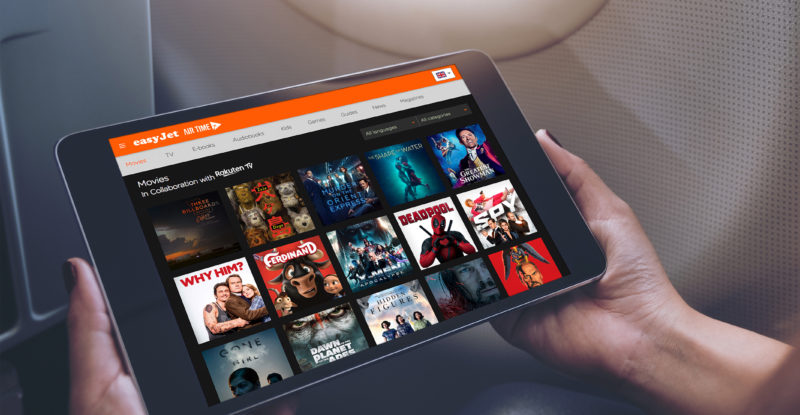Low-cost carrier easyJet has completed the first six-month pilot of the Immfly wireless entertainment solution, installed on five of its aircraft based in Geneva. “I think we have had a good pilot,” Immfly co-founder and head of strategy Jimmy Martinez Von Korff told Runway Girl Network at the Aviation Festival in London.
“We achieved the three main goals that we had in terms of operational efficiency, engagement with passengers, and revenue targets. That gave us an opportunity to move to [the] next stage which is preparing for roll-out.”
But it’s not quite a roll-out yet. Von Korff says easyJet has extended the trial another six months to gather more passenger feedback. “We’re looking forward to continue the process. We have very good synchronization with the [easyJet] team,” he says. “These are companies we like very much to work with because they are very ancillary-oriented, very digital, quite dynamic companies, and they see the potential of what we do.”
Immfly’s roster of clients has been growing; it recently added the Lufthansa/Turkish Airlines joint venture SunExpress, as well as Wamos Air. To date, however, the Pegasus fleet-wide order covering 82 aircraft, which was announced this year at the Aircraft Interiors Expo in Hamburg and could exceed 100 aircraft as the airline grows its fleet, remains Immfly’s biggest contract.
Immfly serves as a marketing and merchandising liaison. It works on behalf of the airline to attract big brands for content and targeted promotions. For instance, Japan’s Rakuten came in on the easyJet deal. Immfly also works with American Express and Volvo, and has a new promotion with Font Vella Levité for Air Nostrum, as recently announced.
“We want to use our technology to help the airline build these commercial partnerships with third [party] companies that extend their ecosystem of digital services,” von Korff says. And in an opinion that might not be universally appreciated by passengers, Korff adds:
There are so many things – financial services, insurance, video on demand, language courses, photo albums – so many apps in the world that could be relevant for the passenger that moment of flight. We can help the airline capture value, in the interest of the passenger and the third party.
What we really don’t recommend is that the airline buy connectivity and let the passengers go direct to Amazon or to Facebook. Then, Facebook and Amazon are getting the money and the airline is just investing [in the Wi-Fi].
Immfly remains flexible on its server and WAP hardware. “We’re agnostic,” Van Korff explains. “We have some preferences because of reliability, and for providing our services we need to be certain that the hardware is able to guarantee levels of service.”
Van Korff says the company is completing overnight installs with its current hardware and maintenance partners. “Our integrations today are with Kontron, Astronics, and Airbus KID-Systeme. These are the ones that we recommend, but if the airline comes to us and says that we need to integrate with Rockwell or Zodiac, we can do it, technically. We also have integration with portable and semi-embedded solutions, but we believe it is key to be hardware agnostic.”
“The important thing, where there needs to be value, is what to do with this technology: better marketing, more revenue, more data, etc. This is the value,” he continues. “Sometimes what happens with airlines is that they buy all of the hardware but then they lack the infrastructure to exploit all of the opportunities.”
Immfly has previously admitted it is preparing airlines for the migration to full onboard Internet, saying it looks forward to working in collaboration with major connectivity players. And doubtlessly it would like to maintain a relationship with easyJet, even if it pivots to an IFC solution.
But Van Korff has opinions on the status of the European Aviation Network (EAN), which is not yet commercially live (much to the consternation of some passengers).
“It’s not live yet in BA and they were the first customer. What we know is that they are improving a lot and – as with everything, every production line – it will be more efficient with time,” he says. “But it’s one of the big challenges. For us, when we talk to airlines, one of the main concerns [we hear is]: ‘I want that, but if I decide to have it, and I get approval for the investment, I want to have it as soon as possible. I don’t want to wait two to three years installing.’”
Related Articles:
- Airlines tighten contracts for portable wifi as they eye IFC upgrade
- Raft of start-up companies face off in wireless IFE boxing ring
- Panasonic Avionics stays focused on serving its niche in IFE
- Airlines tighten contracts for portable wifi as they eye IFC upgrade
- Press Release: Pegasus picks Immfly as onboard digital service partner
- Press Release: easyJet joins forces with Immfly to launch IFE service
- Press Release: easyJet selects Kontron wireless IFE system hardware











